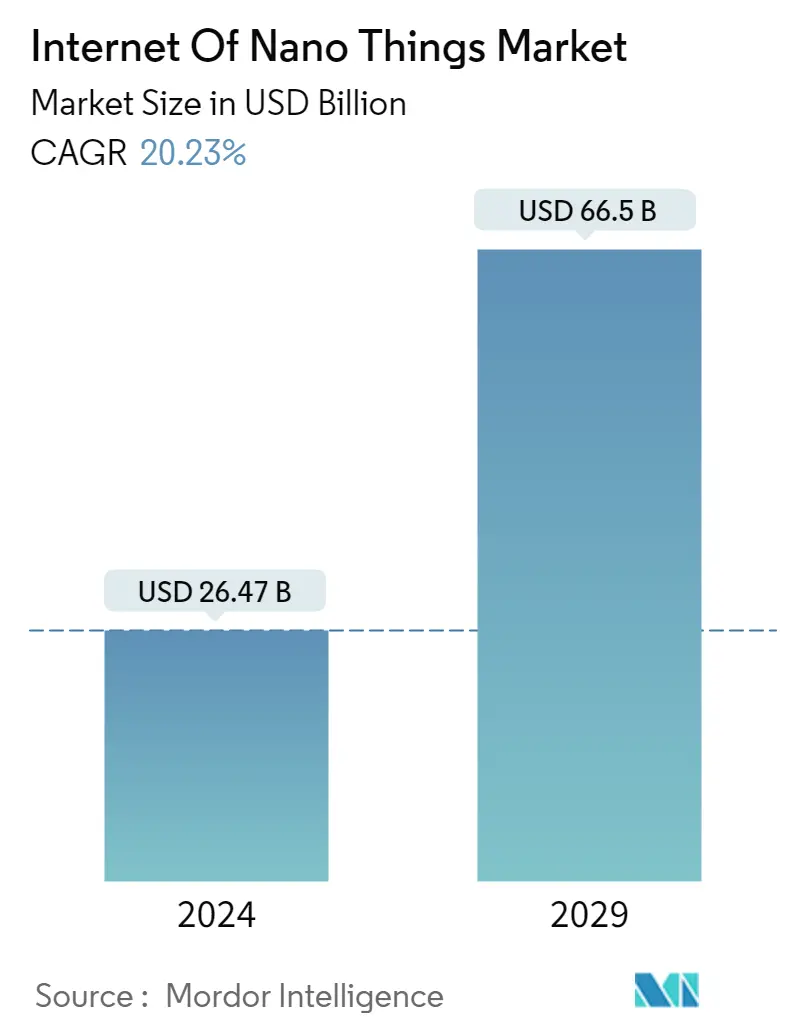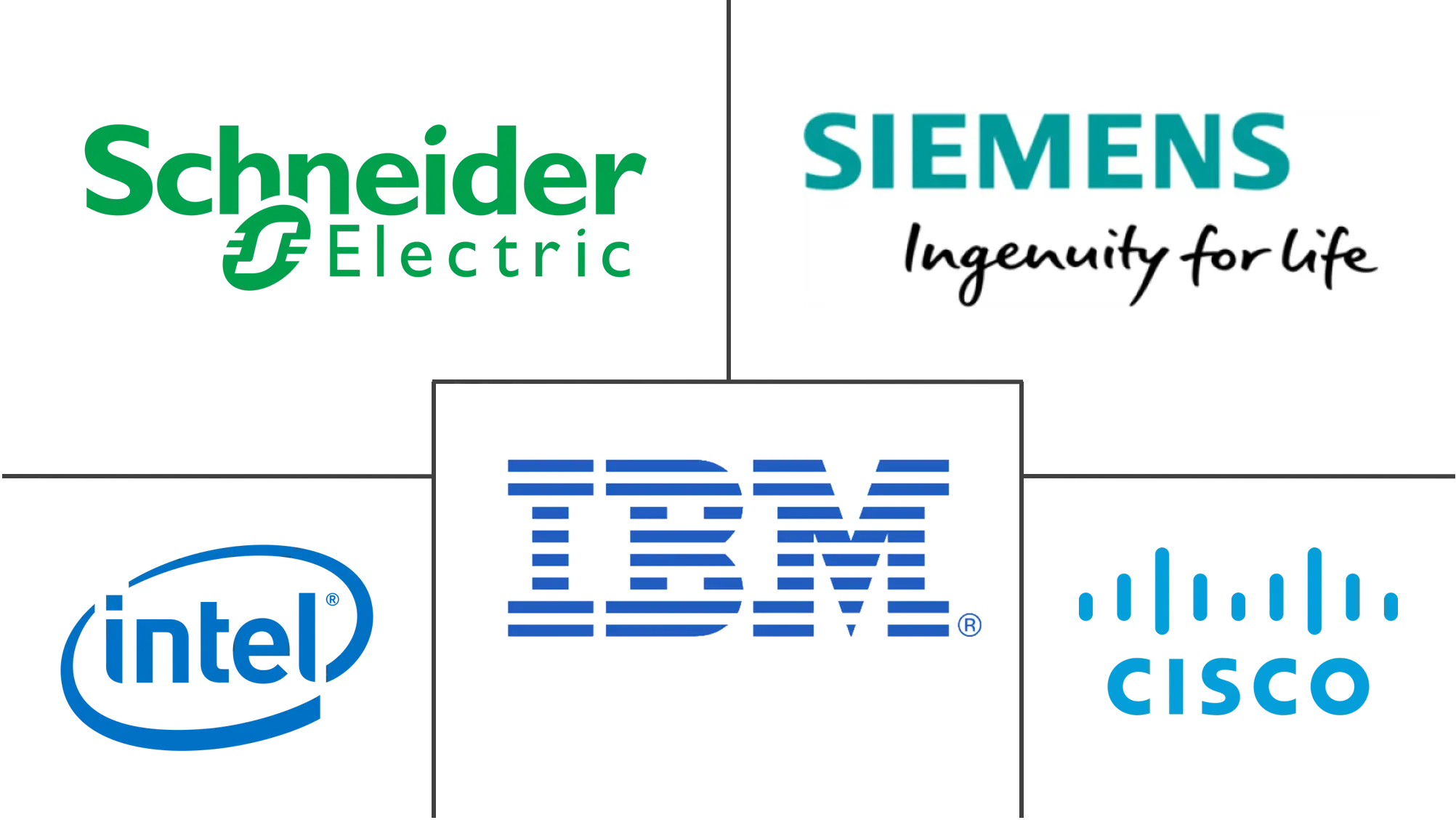Market Size of Internet Of Nano Things Industry

| Study Period | 2019 - 2029 |
| Market Size (2024) | USD 26.47 Billion |
| Market Size (2029) | USD 66.5 Billion |
| CAGR (2024 - 2029) | 20.23 % |
| Fastest Growing Market | Asia Pacific |
| Largest Market | North America |
| Market Concentration | Medium |
Major Players
*Disclaimer: Major Players sorted in no particular order |
Internet Of Nano Things Market Analysis
The Internet Of Nano Things Market size is estimated at USD 26.47 billion in 2024, and is expected to reach USD 66.5 billion by 2029, growing at a CAGR of 20.23% during the forecast period (2024-2029).
- The internet of nano things (IoNT) facilitates the interconnection of nano-sensors and nanodevices with the existing communication technologies in the market, including the internet. Developing nano-machines with communication capabilities and interconnection with micro-and macro-devices will empower IoNT, which is increasingly seen as the next major technological innovation. These devices have dimensions ranging from 1 nm to 100 nm and are interconnected with classical networks, leading to new networking paradigms.
- IoNT is a modern technology that allows numerous nano gadgets to communicate with one another via a high-speed network. IoNT is used for data gathering, pre-processing, and sharing with end users. It also opens up many possibilities with new technologies, such as cloud computing, big data, and machine learning (ML).
- The increased government spending in the aerospace and defense segment is expected to drive the IoNT market during the forecast period, as IoNT has found significant applications in the fields of nano-drones that could be used for monitoring and carrying explosives sufficient enough to penetrate the targetted subject.
- The technological advancements over the past few years have primarily led to the rapid growth of smart environments (offices, homes, and cities, among others). This rapid increase in such environments has paved the way for the interconnectivity of applications and internet usage, prompting the emergence of IoT technology. The expansion of the IoT concept has also given access to IoNT, a new communication network paradigm primarily based on nanotechnology and IoT.
- Nano-drones, employed for monitoring and transporting military troops, are another key use of IoNT. In addition, IoNT can provide more detailed and up-to-date images of cities, houses, and factories. The use of IoNT in smart city projects may monitor various characteristics, such as air and water quality, throughout a metropolis. IoNT can capture real-time data that can be utilized to improve infrastructure, public utilities, and services. Also, rising awareness of the many benefits of IoNT and the development of nano-machines will considerably enhance market revenue growth during the forecast period.
- Nanotechnology systems are expensive and require advanced technology. The high cost is a barrier for many businesses operating on a small and medium scale to use this technology that is planning to deploy expansion strategies in the market.
- The post-COVID-19 era has changed the nature and working conditions of businesses worldwide. Companies automated their operations even more while employees continued to work remotely. IoNT developers were working on implementing IoNT techniques, which helped the IoNT business to flourish. Nano drones helped deliver medical supplies and monitor specific locations, and they were no longer regarded as merely a weapon of war and obscurity. Also, IoNT solutions in the healthcare sector offer numerous benefits, such as lowering service costs and increasing treatment outcomes, propelling the IoNT market forward.
Internet Of Nano Things Industry Segmentation
The scope of the IoNT market study is structured to track spending on hardware, software, and connectivity services across industries such as healthcare, logistics, aerospace, manufacturing, retail, and energy power, among other end-user industries. All data presented in the study is as per the most recent information, and all market projections are adjusted to reflect the impact of COVID-19 on the IoNT market.
The internet of nano things market is segmented by component (hardware, software, and connectivity/services), end-user (healthcare, logistics, defense and aerospace, manufacturing, energy and power, and retail), and geography (North America, Europe, Asia-Pacific, Latin America, and Middle East and Africa). The market sizes and forecasts are provided in terms of value (USD) for all the above segments.
| By Component | |
| Hardware | |
| Software | |
| Connectivity/Services |
| By End User | |
| Healthcare | |
| Logistics | |
| Defense and Aerospace | |
| Manufacturing | |
| Energy and Power | |
| Retail | |
| Other End Users |
| By Geography | |
| North America | |
| Europe | |
| Asia | |
| Australia and New Zealand | |
| Latin America | |
| Middle East and Africa |
Internet Of Nano Things Market Size Summary
The Internet of Nano Things (IoNT) market is poised for significant growth, driven by its integration of nano-sensors and nanodevices with existing communication technologies. This emerging technology facilitates high-speed communication between numerous nano gadgets, enabling advanced data gathering and sharing capabilities. The IoNT is increasingly recognized as a pivotal technological innovation, with applications spanning aerospace, defense, and smart city projects. The market's expansion is further fueled by advancements in nanotechnology, which have enhanced the interconnectivity of applications and internet usage, thereby creating new networking paradigms. Despite the high costs associated with nanotechnology systems, the potential benefits in various sectors, including healthcare and manufacturing, are propelling market growth.
In the healthcare sector, IoNT is revolutionizing patient monitoring and treatment through the use of nanomedicine and nanodevices, offering personalized and timely health interventions. The technology's ability to detect life-threatening disorders early and collect real-time patient data is transforming disease prevention, diagnosis, and treatment. The market is also witnessing increased investments from key players like Intel, IBM, and Schneider Electric, who are focusing on innovative solutions to maintain a competitive edge. The convergence of IoNT with other technologies, such as AI and 5G, is expected to further enhance its applications across various industries, including smart wearables and automated manufacturing processes. As the market continues to evolve, strategic collaborations and technological advancements are likely to drive its growth trajectory.
Internet Of Nano Things Market Size - Table of Contents
-
1. MARKET INSIGHTS
-
1.1 Market Overview
-
1.2 Industry Attractiveness - Porter's Five Forces Analysis
-
1.2.1 Bargaining Power of Suppliers
-
1.2.2 Bargaining Power of Buyers
-
1.2.3 Threat of New Entrants
-
1.2.4 Threat of Substitutes
-
1.2.5 Intensity of Competitive Rivalry
-
-
1.3 Value Chain Analysis
-
1.4 Assessment of the Impact of COVID-19 on the Market
-
1.5 Technology Snapshot
-
-
2. MARKET SEGMENTATION
-
2.1 By Component
-
2.1.1 Hardware
-
2.1.2 Software
-
2.1.3 Connectivity/Services
-
-
2.2 By End User
-
2.2.1 Healthcare
-
2.2.2 Logistics
-
2.2.3 Defense and Aerospace
-
2.2.4 Manufacturing
-
2.2.5 Energy and Power
-
2.2.6 Retail
-
2.2.7 Other End Users
-
-
2.3 By Geography
-
2.3.1 North America
-
2.3.2 Europe
-
2.3.3 Asia
-
2.3.4 Australia and New Zealand
-
2.3.5 Latin America
-
2.3.6 Middle East and Africa
-
-
Internet Of Nano Things Market Size FAQs
How big is the Internet Of Nano Things Market?
The Internet Of Nano Things Market size is expected to reach USD 26.47 billion in 2024 and grow at a CAGR of 20.23% to reach USD 66.5 billion by 2029.
What is the current Internet Of Nano Things Market size?
In 2024, the Internet Of Nano Things Market size is expected to reach USD 26.47 billion.

